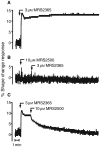(N)-methanocarba-2MeSADP (MRS2365) is a subtype-specific agonist that induces rapid desensitization of the P2Y1 receptor of human platelets
- PMID: 16634757
- PMCID: PMC3413950
- DOI: 10.1111/j.1538-7836.2006.01866.x
(N)-methanocarba-2MeSADP (MRS2365) is a subtype-specific agonist that induces rapid desensitization of the P2Y1 receptor of human platelets
Abstract
Adenosine diphosphate (ADP) initiates and maintains sustained aggregation of platelets through simultaneous activation of both the Gq-coupled P2Y1 receptor and the Gi-coupled P2Y12 receptor. We recently described the synthesis and P2Y1 receptor-specific agonist activity of (N)-methanocarba-2MeSADP (MRS2365). Consequences of selective activation of the P2Y1 receptor by MRS2365 have been further examined in human platelets. Whereas MRS2365 alone only induced shape change, addition of MRS2365 following epinephrine treatment, which activates the Gi/z-linked, alpha2A-adrenergic receptor, resulted in sustained aggregation that was indistinguishable from that observed with ADP. Conversely, the platelet shape change promoted by ADP in the presence of the GPIIb/IIIa antagonist eptifibatide was similar to that promoted by MRS2365. Preaddition of the high affinity P2Y1 receptor antagonist MRS2500 inhibited the effect of MRS2365, whereas addition of MRS2500 subsequent to MRS2365 reversed the MRS2365-induced shape change. Preactivation of the P2Y1 receptor with MRS2365 for 2 min resulted in marked loss of capacity of ADP to induce aggregation as evidenced by a greater than 20-fold rightward shift in the concentration effect curve of ADP. This inhibitory effect of P2Y1 receptor activation was dependent on the concentration of MRS2365 (EC50 = 34 nm). The inhibitory effect of preincubation with MRS2365 was circumvented by activation of the Gq-coupled 5-HT2A receptor suggesting that MRS2365 induces loss of the ADP response as a consequence of desensitization of the Gq-coupled P2Y1 receptor. The time course of MRS2365-induced loss of aggregation response to epinephrine was similar to that observed with ADP. These results further demonstrate the P2Y1 receptor selectivity of MRS2365 and illustrate the occurrence of agonist-induced desensitization of the P2Y1 receptor of human platelets studied in the absence of P2Y12 receptor activation .
Figures









Similar articles
-
Induction of novel agonist selectivity for the ADP-activated P2Y1 receptor versus the ADP-activated P2Y12 and P2Y13 receptors by conformational constraint of an ADP analog.J Pharmacol Exp Ther. 2004 Dec;311(3):1038-43. doi: 10.1124/jpet.104.068650. Epub 2004 Sep 2. J Pharmacol Exp Ther. 2004. PMID: 15345752 Free PMC article.
-
Nucleoside triphosphates inhibit ADP, collagen, and epinephrine-induced platelet aggregation: role of P2Y₁ and P2Y₁₂ receptors.Thromb Res. 2013 Nov;132(5):548-57. doi: 10.1016/j.thromres.2013.08.021. Epub 2013 Sep 1. Thromb Res. 2013. PMID: 24071464
-
Agonist concentration-dependent differential responsivity of a human platelet purinergic receptor: pharmacological and kinetic studies of aggregation, deaggregation and shape change responses mediated by the purinergic P2Y1 receptor in vitro.Platelets. 2003 Nov-Dec;14(7-8):445-62. doi: 10.1080/09537100310001612399. Platelets. 2003. PMID: 14713514
-
The role of ADP receptors in platelet function.Front Biosci. 2006 May 1;11:1977-86. doi: 10.2741/1939. Front Biosci. 2006. PMID: 16368572 Review.
-
Agonists and antagonists for P2 receptors.Novartis Found Symp. 2006;276:58-68; discussion 68-72, 107-12, 275-81. doi: 10.1002/9780470032244.ch6. Novartis Found Symp. 2006. PMID: 16805423 Free PMC article. Review.
Cited by
-
Nucleotide P2Y1 receptor agonists are in vitro and in vivo prodrugs of A1/A3 adenosine receptor agonists: implications for roles of P2Y1 and A1/A3 receptors in physiology and pathology.Purinergic Signal. 2020 Dec;16(4):543-559. doi: 10.1007/s11302-020-09732-z. Epub 2020 Oct 31. Purinergic Signal. 2020. PMID: 33129204 Free PMC article.
-
Ser352 and Ser354 in the carboxyl terminus of the human P2Y(1) receptor are required for agonist-promoted phosphorylation and internalization in MDCK cells.Br J Pharmacol. 2011 Mar;162(6):1304-13. doi: 10.1111/j.1476-5381.2010.01135.x. Br J Pharmacol. 2011. PMID: 21108629 Free PMC article.
-
Long-term platelet priming after glycoprotein VI stimulation in comparison to Protease-Activating Receptor (PAR) stimulation.PLoS One. 2021 Mar 3;16(3):e0247425. doi: 10.1371/journal.pone.0247425. eCollection 2021. PLoS One. 2021. PMID: 33657162 Free PMC article.
-
Synthesis of ethyl (1S,2R,3S,4S,5S)-2,3-O-(isopropylidene)-4-hydroxy-bicyclo[3.1.0]hexane-carboxylate from L-ribose: a versatile chiral synthon for preparation of adenosine and P2 receptor ligands.Nucleosides Nucleotides Nucleic Acids. 2008 Mar;27(3):279-91. doi: 10.1080/15257770701845253. Nucleosides Nucleotides Nucleic Acids. 2008. PMID: 18260011 Free PMC article.
-
Attenuation of apoptosis in vitro and ischemia/reperfusion injury in vivo in mouse skeletal muscle by P2Y6 receptor activation.Pharmacol Res. 2008 Sep-Oct;58(3-4):232-9. doi: 10.1016/j.phrs.2008.08.004. Epub 2008 Aug 30. Pharmacol Res. 2008. PMID: 18805489 Free PMC article.
References
-
- Gaarder A, Jonsen J, Laland S, Hellem A, Owren PA. Adenosine diphosphate in red cells as a factor in the adhesiveness of human blood platelets. Nature. 1961;192:531–2. - PubMed
-
- Harden TK, Barnard EA, Boeynaems JM, Burnstock G, Dubyak GR, Hourani SMO, Insel PA. P2Y receptors. In: Girdlestone D, editor. The IUPHAR Compendium of Receptor Characterization and Classification. London: IUPHAR Media; 1998. pp. 209–17.
-
- Hollopeter G, Jantzen HM, Vincent D, Li G, England L, Ramak-rishnan V, Yang RB, Nurden P, Nurden A, Julius D, Conley PB. Identification of the platelet ADP receptor targeted by antithrombotic drugs. Nature. 2001;409:202–7. - PubMed
-
- Communi D, Gonzalez NS, Detheux M, Brézillon S, Lannoy V, Parmentier M, Boeynaems JM. Identification of a novel human ADP receptor coupled to Gi. J Biol Chem. 2001;276:41479–85. - PubMed
-
- Burnstock G. Introduction: P2 receptors. Curr Top Med Chem. 2004;4:793–803. - PubMed
Publication types
MeSH terms
Substances
Grants and funding
LinkOut - more resources
Full Text Sources
Other Literature Sources

